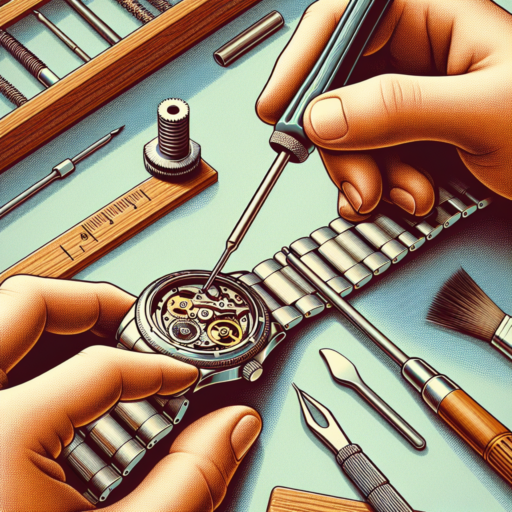How to take a bracelet off of a watch?
Removing a bracelet from a watch is a delicate task that requires patience and the right tools. Whether you’re looking to swap your bracelet for a new style or perform a thorough cleaning, understanding the process is essential. First, it’s important to identify the type of attachment your watch bracelet has, as this will determine the specific steps you need to follow.
Preparing Your Workspace
Before beginning, it’s vital to create a safe and secure workspace. Lay down a soft cloth on a flat surface to protect the watch from getting scratched. Make sure you have good lighting and that all necessary tools are within reach. Common tools for this task include a spring bar tool, a small screwdriver, or a pin remover, depending on your watch’s bracelet attachment mechanism.
Step-by-Step Guide to Bracelet Removal
To remove the bracelet, start by locating the spring bars or screws that secure it to the watch case. For spring bars, use the forked end of the spring bar tool to compress one end of the spring bar inward and gently release it from the lug. If your watch bracelet is secured with screws, use the appropriate size screwdriver to carefully unscrew them. It’s crucial to apply gentle pressure to avoid damaging the watch case or bracelet. Always keep the springs or screws in a safe place to prevent loss.
Understanding the proper way to remove your watch’s bracelet can enhance your watch’s longevity and allow you to customize its look to suit different occasions. Remember, if at any point the task feels overwhelming, seeking professional help is the safest option.
How to remove watch bracelet without tool?
Removing a watch bracelet without the specialized tools might seem daunting, but with patience and the right technique, you can do it safely and effectively. One of the most common methods includes using household items that mimic the function of professional tools. This guide will explore some of these techniques, ensuring you can adjust or remove your watch bracelet without causing damage.
Using a Paperclip
One popular method involves using a straightened paperclip. First, locate the pins or screws that hold your bracelet links together. Carefully insert one end of the paperclip into the pinhole, applying gentle pressure until the pin budges. It requires a steady hand and patience, but it’s a remarkably effective makeshift tool.
Employing a SIM Card Tool
If you’ve ever changed a SIM card on a smartphone, you likely have a SIM card tool. This small, pointed object is perfect for reaching into narrow spaces. Similar to the paperclip method, align the tool with the pinhole and gently push. The precision of the SIM card tool can make this method slightly easier, offering better control and minimizing the risk of scratching your watch.
While using household items can be convenient, it’s crucial to proceed with caution. Always ensure your workstation is well-lit and that you’re applying force in the correct direction to avoid injuries or damaging your watch. Remember, these techniques are handy in a pinch but consider investing in professional tools for frequent adjustments.
How to remove metal band from watch?
Removing a metal band from a watch might seem daunting at first, but with the right tools and a bit of patience, you can accomplish this task smoothly and safely. Before you start, ensure you’re working on a clean, flat surface and have a soft cloth down to prevent any scratches on your watch.
Identify the Band Type
First, identify the type of metal band your watch has. Different types, such as link, mesh, or expansion bands, require slightly different approaches for removal. For link bands, look for the small pins on the side; these are the key to adjusting or removing the band. Mesh bands typically have an adjustable clasp that you can slide to resize or remove, while expansion bands stretch to fit and may need a specific tool for adjustment.
Tools You’ll Need
Gather the necessary tools before starting. A small jeweler’s screwdriver, a pin pusher, or even a small paperclip can be helpful. In the case of link bands with push pins, using a pin pusher is the most efficient way to safely remove the pins without damaging your watch. If you’re working with a screw-type link, the screwdriver will be essential. Ensure that the tools you choose fit the pins or screws perfectly to avoid slipping and scratching your watch.
Steps for Removal
- Steady your watch on the soft cloth, ensuring it’s face down to prevent damage.
- Locate the pins or screws holding the band in place. For pins, use your pin pusher or paperclip to gently push them out. For screws, carefully unscrew them with your screwdriver.
- Once the pins or screws are removed, gently separate the band from the watch case. If you’re planning to replace the band, keep all components, like pins or screws, in a safe place.
No se han encontrado productos.
How to unclasp a bracelet watch?
Unlocking a bracelet watch can sometimes feel like solving a puzzle. Whether you’re dealing with a new watch or one that has become tighter over time, the right technique makes all the difference. This guide breaks down the steps to unclasp your bracelet watch smoothly and effortlessly.
Identify the Clasp Type
First, closely examine your watch to identify the type of clasp it has. The most common types are the fold-over clasp, the push-button release clasp, and the sliding clasp. Knowing your clasp type is essential as each type has its unique method of opening.
Steps to Unclasp
- Fold-over Clasp: Look for the flap or tab that locks the clasp in place. Use your nail or a small tool to gently lift the tab away from the bracelet. This action releases the lock, allowing you to unfold the clasp fully.
- Push-button Release Clasp: Find the buttons located on either side of the clasp. Press them simultaneously to release the locking mechanism. Some models may have a single button, which should also be pressed to unlock.
- Sliding Clasp: Hold the bracelet securely with one hand while you locate the slidable part of the clasp with the other. Gently push or pull (depending on the design) the movable part to adjust the bracelet’s size or to open it completely.



